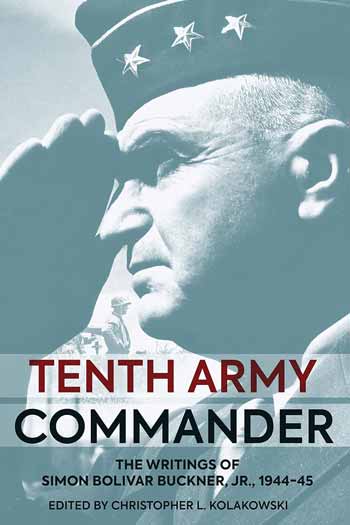Edited by Christopher L. Kolakowski.
Philadelphia: Casemate Publishers, 2023.
ISBN 978-1-63624-199-9. Photographs. Maps.
Notes. Bibliography. Index.
Pp. xi, 255. $34.95.
The life and command of Simon Bolivar Buckner Jr. have been absent from the annals of World War II history. Christopher L. Kolakowski skillfully weaves notes, journals, and letters from Bolivar to illustrate his eighteen months of command and eleven months of leading Tenth Army. Kolakowski supports the general’s diary with three supporting chapters highlighting his early life through his assignment commanding the Tenth Army. The final chapters guide the reader through the general’s final day and an assessment of his performance as an Army field commander.
Kolakowski’s brief biographical chapter spans Buckner’s early life, including his famous and accomplished father. Buckner played a significant role in the Army’s educational system in the pre-World War II era, culminating with his tenure as Assistant Commandant and Commandant of Cadets at West Point. Buckner was also critical to the development and modernization of Alaska’s defensive footprint. Buckner’s defense of Alaska demonstrates the critical value of layered defense, organization, and infrastructure in deterring and defeating a determined and capable enemy force.
The heart of the book focuses on Buckner’s diary, which chronicles the post-Aleutian battle through his tenure as commander of Tenth Army. Kolakowski divides the diary’s twelve months into four chapters. Chapter two is remarkably ordinary, yet it clearly illustrates the importance of an active commander circulating through his area of responsibility and ensuring the readiness and welfare of his troops while he waits for orders. The pace picks up as Buckner is summoned to Washington to assume command of Tenth Army. As the story transitions from homeland defense in Alaska to combat operations with Tenth Army, Kolakowski frames the diary with a description of the Pacific Theater and structure under Admiral Chester W. Nimitz and the ground forces commanders under him as opposed to General Douglas MacArthur’s Southwest Pacific Area Theater.
On 5 July 1944, Tenth Army was formally created, with Buckner assuming command. One of the most consequential elements of Buckner’s diary and the history of Tenth Army is its development as a joint organization with cooperation and coordination between the Navy, Army, Marines, and Army Air Forces. Buckner’s diary vividly describes the commitment of a senior officer who excels in joint operations with ground forces composed of Army and Marine units and supported by naval and air forces. The structure of Buckner’s Tenth Army bears more resemblance to a modern twenty-first-century force than it does to a pre-atomic force. His ability to form personal and professional relationships with his superiors, peers, and subordinates enabled him to succeed and avoid interservice rivalries.
Buckner’s leadership demonstrated his ability to be a good follower and set an example as a creative, critical thinker, and strategic leader. Throughout his command positions from 1940 until his death, Buckner exhibited the ability to work well in an interservice environment. The journal details eight months of planning, organizing, and preparing a joint force for major combat operations. Buckner exhibits significant energy to ensure the readiness of Marine and Army divisions and corps under his command. The lessons shared in Buckner’s concise notes are just as relevant today. The modern force has decades of experience preparing a small rotational force for continuous rotations. Buckner’s actions describe the depth of planning and coordination required across a joint force to build a field Army that represents a third of the modern Army’s entire strength.
Kolakowski narrates Buckner’s final day and a heartfelt letter from his chief of staff, Eddie Post, to Buckner’s widow, Adele. He concludes the volume with a thorough analysis of Buckner’s time in command. He references the description of an Army commander from a 1942 field service regulation and compares Buckner’s service with that of other Army field commanders. Kolakowski’s insights are poignant and fair, supported by analysis from Buckner’s contemporaries and later historians. Kolakowski’s volume is critical to the study of large-scale joint combat operations. It should be studied more thoroughly to address modern interoperability, standardization, rationalization, and doctrinal compatibility concerns between combined and joint forces.
Sergeant Major Zach Wriston
El Paso, Texas
